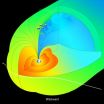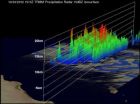(Press-News.org) While the United States has largely been spared the scourge of mosquito-borne diseases endemic to the developing world—including yellow fever, malaria and dengue fever—mosquito-related illnesses in the US are on the rise. One pathogen of increasing concern in the U.S. is an arbovirus known as West Nile.
Now Qiang "Shawn" Chen, a researcher at Arizona State University's Biodesign Institute and a professor in the College of Technology and Innovation has developed a new method of testing for West Nile, using plants to produce biological reagents for detection and diagnosis.
The new research, conducted by Chen and his colleagues at the Center for Infectious Diseases and Vaccinology recently appeared in the Journal of Biomedicine and Biotechnology.
"One critical issue in WNV diagnosis concerns the difficulty of distinguishing WNV infection from other closely related diseases, such as St. Louis encephalitis and dengue fever, due to the cross-reactivity of antibodies among flaviviruses," Chen says. "It is important to develop better diagnostic tools with enhanced accuracy for both treatment and diagnostic purposes."
Thus far, the 2012 outbreak of West Nile in the United States is on track to be one of the worst on record. According to the Center for Disease Control, 48 states have reported West Nile virus infections in people, birds, or mosquitoes as of October 9th of this year.
To date, 4,249 cases of West Nile virus disease have been reported in humans, including 168 deaths. Of these cases 2,123 (50 percent) appeared in the more severe or neuroinvasive form of the disease, causing meningitis and encephalitis, while 2,126 cases were classified as non-neuroinvasive.
These figures represent the highest number of West Nile cases reported to the CDC since 2003, with nearly 70 percent reported from eight states: Texas, California, Louisiana, Mississippi, South Dakota, Michigan, Oklahoma, and Illinois. Over a third of total cases have been reported from Texas.
The alarming upswing in West Nile cases coupled with their broad geographic distribution demand new techniques for both diagnosis and treatment. Chen and his colleagues have been exploiting the power of plant biotechnology to achieve these goals.
Earlier, Chen's group developed the first successful plant-derived therapeutic to combat West Nile post-infection, reporting their results in the Proceedings of the National Academy of Science. The current study advances efforts to create a diagnostic test for West Nile that will overcome barriers of existing methods, including limited accuracy, prohibitive cost and scalability.
In nearly all cases, West Nile is transmitted to humans through the bite of an infected mosquito. Mosquitoes acquire the virus after feeding on infected birds. The virus then migrates to the mosquito's salivary glands, from which it may be injected into humans and animals. There, it can multiply and produce characteristic symptoms of West Nile disease. These may present as flu-like malaise including fever and chills, headaches, fatigue and pain in muscles and joints. Symptoms typically last three to six days, but may persist for weeks.
In around 1 in 150 WNV cases, individuals develop infections of the brain (encephalitis) or surrounding tissue (meningitis), often producing severe headache, fever, stiffness, confusion, convulsions, coma, tremors, muscle weakness and paralysis. Those with neurologic involvement may require weeks of hospitalization and may suffer permanent health effects including muscle weakness and paralysis. Around 10 percent of people with WNV encephalitis die.
Faced with the growing threat of mosquito-borne epidemics, researchers like Chen stress the necessity of developing rapid, low-cost platforms for diagnosis of West Nile. Traditionally, cell cultures from serum, cerebrospinal fluid or tissues have been examined but the short viremic phase and low viral count of WNV in blood and spinal fluid limit the sensitivity and accuracy of such tests. Protein-based methods like ELISA have become standard tests for West Nile, yielding better results but at considerably higher cost and with limited scalability.
In the current study, plants were exploited for their ability to produce large volumes of proteins that can be used for diagnostic testing. As Chen explains, proteins produced in this way traditionally require a lengthy time period before transgenic plant lines can be established. By contrast, the new method, which makes use of plant viral-based vectors like Tobacco Mozaic Virus and Gemini Virus, relies on the ability of plants to transiently express particular target genes, yielding the desired protein in 1-2 weeks.
The technique provides the speed and flexibility of a bacterial gene expression system while permitting the posttranslational modifications of proteins afforded by mammalian cell culture approaches.
Chen's group used plant transient expression systems to produce two varieties of protein reagents useful for the detection and diagnosis of WNV—one a recombinant antigen and one a monoclonal antibody. High expression levels of both reagents were observed in two kinds of plants: Nicotiana benthamiana (a close relative of tobacco) and lettuce. The two reagents may be readily purified to greater than 95 percent and retain their native functionality and specificity.
The production of plant-derived antigens and monoclonal antibodies offers an attractive alternative to the use of mammalian, insect or bacterial cell cultures and demonstrates the capability of plants to provide accurate and flexible diagnostic reagents not only for WNV but a broad range of arboviruses affecting human health.
"Our test will improve the accuracy of diagnosis, leading to the proper treatment of patients affected by WNV," Chen says. "The plant-derived monoclonal antibody we examined is not only low-cost, but highly specific for WNV antigen and does not recognize antigens from other flaviviruses." Chen further notes that application of this research will ultimately allow a broad range of WNV surveillance capabilities, from clinical diagnosis to global distribution patterns in wild bird and mosquito populations.
West Nile Facts
The West Nile Virus (WNV) is an arbovirus belonging to the Flavivirus genus of the Flaviviridae family
Mosquitoes that have acquired the virus from infected birds transmit WNV.
First identified in the Eastern Hemisphere and widely distributed in Africa, Asia, Europe and the Middle East, WNV entered the Western Hemisphere in 1999, via New York City.
Since its American debut, WNV has infected over 30,000 people with severe forms of the disease, with an untold number of additional cases remaining undiagnosed.
Infection with WNV can be asymptomtic or can lead to West Nile fever or severe West Nile disease.
Around 20 percent of people who become infected with WNV will develop West Nile fever, with symptoms including fever, headache, exhaustion and body aches, occasionally with a skin rash (on the trunk of the body) and swollen lymph glands. The illness can last from a few days to several weeks.
The symptoms of severe WNV disease—also known as neuroinvasive disease, including West Nile encephalitis or meningitis or West Nile poliomyelitis— include headache, high fever, neck stiffness, stupor, disorientation, coma, tremors, convulsions, muscle weakness, and paralysis.
Approximately 1 in 150 people infected with WNV develop a more severe form of disease. While serious illness can occur in people of any age, those over 50 as well as individuals with compromised immunity (including transplant patients) are at the highest risk for severe illness following WNV infection.
The incubation time for WNV is typically 2 to 15 days. It is believed that infection confers lifelong immunity to the virus.
This year (2012) has seen a serious uptick in West Nile cases and will go on record as among the most severe in terms of case numbers.
According to Scientific American, a mild winter and a hot, dry summer have contributed to the rapid spread of WNV across the U.S. this year. Climate change has been implicated as a factor exacerbating the spread of WNV.
The susceptibility to severe symptoms of WNV disease appears linked to genetic traits. Further, advanced age is one of the primary risk factors for severe neurological disease, long-term morbidity and death.
Plant production for diagnostic protein reagents may easily be scaled up to suit existing need, as in the case of a sudden WNV epidemic.
Plants are ideal protein bioreactors, due to their capacity to produce large volumes or proteins at low cost and their ability to make appropriate posttranslational modifications of proteins.
Currently, there is no vaccine against WNV, nor effective therapeutics approved for human use. The best tactics of prevention are:
Cover exposed skin with long pants and long-sleeved shirts, particularly during early morning or evening hours when mosquitoes are most active
Use insect repellent
Keep window screens in good repair
Try to reduce or eliminate areas of standing water where mosquitoes breed, including bird baths, wading pools, tire swings, etc
INFORMATION:
Written by: Richard Harth
Science Writer: The Biodesign Institute
richard.harth@asu.edu
Plants provide accurate low-cost alternative for diagnosis of West Nile Virus
2012-10-25
ELSE PRESS RELEASES FROM THIS DATE:
NASA study using cluster reveals new insights into solar wind
2012-10-25
A new study based on data from European Space Agency's Cluster mission shows that it is easier for the solar wind to penetrate Earth's magnetic environment, the magnetosphere, than had previously been thought. Scientists from NASA's Goddard Space Flight Center in Greenbelt, Md. have, for the first time, directly observed the presence of certain waves in the solar wind—called Kelvin-Helmholtz waves that can help transfer energy into near-Earth space—under circumstances when previous theories predicted they were not expected.
The recent paper, published on Aug 29, 2012, ...
Galaxy halos are produced by orphan stars, findings indicate
2012-10-25
Irvine, Calif., Oct. 24, 2012 – Isolated stars kicked to the edges of space by violent galaxy mergers may be the cause of mysterious infrared light halos observed across the sky, according to UC Irvine and other astronomers.
"Background glow in our sky has been a huge unanswered question," said UCI physics & astronomy professor Asantha Cooray, lead author of a paper about the discovery in the Oct. 25 issue of the journal Nature. "We have new evidence that this light is from stars that linger between galaxies. Individually, they're too dim to be seen, but we think we're ...
Video game with biofeedback teaches children to curb their anger
2012-10-25
Boston, Mass. , Oct. 24, 2012—Children with serious anger problems can be helped by a simple video game that hones their ability to regulate their emotions, finds a pilot study at Boston Children's Hospital. Results were published online October 24 in the journal Adolescent Psychiatry.
Noticing that children with anger control problems are often uninterested in psychotherapy, but very eager to play video games, Jason Kahn, PhD, and Joseph Gonzalez-Heydrich, MD, at Boston Children's Hospital developed "RAGE Control" to motivate children to practice emotional control skills ...
NASA satellite shows the Tropical Storm Son-tinh's reach over Philippines
2012-10-25
The latest tropical storm in the western North Pacific Ocean has already spread its clouds and showers over the Philippines, as seen in NASA satellite imagery. NASA's Aqua satellite captured an image as it flew over Tropical Storm Son-tinh today, Oct. 24.
On Oct. 24, 2012 at 0445 UTC (12:45 a.m. EDT) the Moderate Resolution Imaging Spectroradiometer (MODIS) instrument that flies aboard NASA's Aqua satellite captured a visible image of Tropical Storm Son-tinh. At the time of the image, Son-tinh's center was moving through the central Philippines, but its cloud cover extended ...
Revealing a mini-supermassive black hole
2012-10-25
One of the lowest mass supermassive black holes ever observed in the middle of a galaxy has been identified, thanks to NASA's Chandra X-ray Observatory and several other observatories. The host galaxy is of a type not expected to harbor supermassive black holes, suggesting that this black hole, while related to its supermassive cousins, may have a different origin.
The black hole is located in the middle of the spiral galaxy NGC 4178, shown in this image from the Sloan Digital Sky Survey. The inset shows an X-ray source at the position of the black hole, in the center ...
NASA's TRMM satellite sees birth of Arabian Sea cyclone
2012-10-25
NASA's TRMM satellite measured rainfall and towering clouds within the Arabian Sea's first tropical cyclone of the season as it passed overhead from space. Meanwhile, the infrared AIRS instrument aboard NASA's Aqua satellite noticed that strong thunderstorms surrounded the center of the storm. Tropical Cyclone 1A is expected to be short-lived as it heads for a landfall in Somalia on Oct. 25.
Since it was launched in 1997 the Tropical Rainfall Measuring Mission (TRMM) satellite has been useful for monitoring tropical cyclones in the tropics. TRMM passed above the first ...
Moderate drinking decreases number of new brain cells
2012-10-25
Drinking a couple of glasses of wine each day has generally been considered a good way to promote cardiovascular and brain health. But a new Rutgers University study indicates that there is a fine line between moderate and binge drinking – a risky behavior that can decrease the making of adult brain cells by as much as 40 percent.
In a study posted online in the journal Neuroscience, scheduled to be published on November 8, lead author Megan Anderson, a graduate student working with Dr. Tracey J. Shors, Professor II in Behavioral and Systems Neuroscience in the Department ...
Study shows whites twice as likely as blacks to get CPR from bystanders
2012-10-25
AURORA, Colo. (Oct. 24, 2012) – In the first study of its kind, researchers have found that those who suffer cardiac arrests in upper income, white neighborhoods are nearly twice as likely to get cardiopulmonary resuscitation (CPR) than people who collapse in low-income, black neighborhoods.
"If you drop in a neighborhood that is 80 percent white with a median income over $40,000 a year, you have a 55 percent chance of getting CPR," said study author Comilla Sasson, MD, an emergency room physician at the University of Colorado Hospital. "If you drop in a poor, black neighborhood ...
Reclaiming rare earths
2012-10-25
Recycling keeps paper, plastics, and even jeans out of landfills. Could recycling rare-earth magnets do the same? Perhaps, if the recycling process can be improved.
Scientists at the U.S. Department of Energy's (DOE) Ames Laboratory are working to more effectively remove the neodymium, a rare earth element, from the mix of other materials in a magnet. Initial results show recycled materials maintain the properties that make rare-earth magnets useful.
The current rare earth recycling research builds on Ames Laboratory's decades of rare-earth processing experience. In ...
Sleep-deprived bees have difficulty relearning
2012-10-25
Everyone feels refreshed after a good night's sleep, but sleep does more than just rejuvenate, it can also consolidate memories. 'The rapid eye movement form of sleep and slow wave sleep are involved in cognitive forms of memory such as learning motor skills and consciously accessible memory', explains Randolf Menzel from the Freie Universtät Berlin, Germany. According to Menzel, the concept that something during sleep reactivates a memory for consolidation is a basic theory in sleep research. However, the human brain is far too complex to begin dissecting the intricate ...





